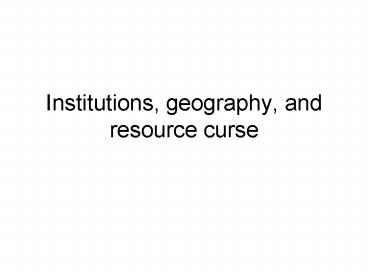Institutions, geography, and resource curse - PowerPoint PPT Presentation
1 / 8
Title:
Institutions, geography, and resource curse
Description:
Institutions, geography, and resource curse Natural resources and resource curse Countries endowed with natural resources often try the export-led-growth strategy ... – PowerPoint PPT presentation
Number of Views:149
Avg rating:3.0/5.0
Title: Institutions, geography, and resource curse
1
Institutions, geography, and resource curse
2
Natural resources and resource curse
- Countries endowed with natural resources often
try the export-led-growth strategy - Resource curse on average, those countries
have lower rates of economic growth and poor
institutions (Mehlum, Halvor, Moene, Karl and
Ragnar Torvik, (2006), Institutions and resource
curse) - Dutch disease export sectors drain resources
from other sectors of economy - resource rents create an incentive for dictators
to cling to power, and also reduce their need for
institutions that protect property rights
(Egorov, Georgy, Guriev, Sergei M. and Sonin,
Konstantin, (2006) "Media Freedom, Bureaucratic
Incentives, and the Resource Curse) - Resource curse can be overcome if country has
well developed institutions (Norway, Canada,
Australia )
3
Institutions, geography, and trade
- Growth theories emphasize the role of
accumulation of physical and human capital but do
not give an answer for - why did some societies manage to accumulate and
innovate more rapidly than others? - Estimate the respective contributions of
institutions, geography, and trade in determining
income levels around the world (Institutions
Rule The Primacy of Institutions over Geography
and Integration in Economic Development, Dani
Rodrik, Arvind Subramanian, and Francesco Trebbi
NBER Working Paper No. 9305 October 2002)
4
Theories of development by Danni Rodrick et al
- First, there is a long and distinguished line of
theorizing that places geography at the center of
the story. - A second camp emphasizes the role of
international trade as a driver of productivity
change. We call this the integration view, as it
gives market integration a starring role in
fostering economic convergence between rich and
poor regions of the world. - A third group of explanations centers on
institutions, and in particular the role of
property rights and the rule of law. In this
view, what matters are the rules of the game in a
society and their conduciveness to desirable
economic behavior.
5
(No Transcript)
6
Empirical approach
- Historians and many social scientists prefer
nuanced, layered explanations where these factors
interact with human choices and many other
not-so-simple twists and turns of fate. But
economists like parsimony. We want to know how
well these simple stories do, not only on their
own or collectively, but more importantly,
vis-à-vis each other. - How much of the astounding variation in
cross-national incomes around the world can
geography, integration, and institutions explain?
- Do these factors operate additively, or do they
interact? - Are they all equally important?
- Does one of the explanations trump the other
two?
7
(No Transcript)
8
Results
- A. Institutions rule
- B. The primacy of institutional quality does not
imply policy ineffectiveness - there are substantial economic gains from
improving institutions - C. The hard work is still ahead
- It is helpful to know that geography is not
destiny, or that focusing on increasing the
economys links with world markets is unlikely to
yield convergence. But the operational guidance
that our central result on the primacy of
institutional quality yields is extremely meager.































